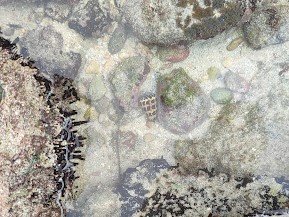By Lidia Colejo Durán, PhD student at l’Université de Sherbrooke
My recent trip to Bali was a mesmerizing blend of green landscapes, vibrant culture, and captivating wildlife encounters. As a biologist, experiencing the island’s rich biodiversity firsthand was nothing short of a dream come true. Among the many highlights of my adventure, three experiences stood out: encountering cone snails in Nusa Penida, observing mantis shrimps in Tulamben, and mingling with monkeys in the Ubud Monkey Forest.

Cone Snails in Nusa Penida
Nusa Penida, a stunning island southeast of Bali, is renowned for its crystal-clear waters and diverse marine life. After a relaxing day at the beach, we decided to explore the tide pools during low tide. It was fascinating to observe crabs, shrimps, and other marine creatures up close. Amidst this exploration, I spotted a particularly pretty shell and picked it up. Not realizing its potential danger, I showed it to my friend and exclaimed, “Oh, it’s alive!” She calmly but firmly said, “Put that down!” Only later did I learn that it was a venomous cone snail, making this a near-death experience that reminded me of the hidden dangers lurking beneath the ocean’s serene surface. That would have been a “dumb way to die”.

Mantis Shrimps in Tulamben
Tulamben, with its black sand beaches and renowned Liberty shipwreck dive site, provides an ideal environment for these fascinating crustaceans. There we completed our PADI training for scuba diving, which allowed us to explore the underwater world more deeply. We encountered playful clownfish nestled among the anemones and were delighted by the sight of majestic Napoleon fish. Playing with the anemones and observing their delicate tentacles was an unforgettable experience. During one of our dives, we came face-to-face with another incredible marine creature: the mantis shrimp. Famous for their vibrant colors and extraordinary hunting skills, mantis shrimps are a wonder to observe. The mantis shrimp’s unique ability to perceive polarized light and a wide spectrum of colors added another layer to their intrigue. I was so fascinated and in love with their rainbow colors that I could have watched them for hours.


Monkeys in the Ubud Monkey Forest
No trip to Bali would be complete without visiting the Ubud Monkey Forest, a sanctuary for hundreds of long-tailed macaques. Nestled in the heart of Ubud, this lush forest is not only a haven for monkeys but also a place of spiritual and cultural significance. We were warned not to bring any food, glasses, or accessories, but one monkey still managed to steal the bright yellow waterproof cover of my bag. I tried to beg for it back, but the monkey was not very cooperative. Their curious and mischievous behavior provided endless entertainment, but it was essential to stay cautious and respectful of their space. The Ubud Monkey Forest offered a unique glimpse into the symbiotic relationship between humans and wildlife, highlighting the importance of conservation efforts in preserving such natural treasures.


A Biologist’s Paradise
Being a biologist in such a vibrant and diverse ecosystem was a true privilege. Bali’s flora is as captivating as its fauna, with a myriad of flowers and plants thriving in the island’s hot and super-humid climate. The tropical environment supports an array of vegetation, from fragrant frangipanis and colorful hibiscus to towering bamboo and lush ferns. The island’s climate, though often challenging with its intense heat and humidity, creates the perfect conditions for this lush growth, making every moment spent exploring Bali a botanical delight.

Conclusion
Bali’s diverse wildlife, from the venomous cone snails of Nusa Penida to the colorful mantis shrimps of Tulamben and the lively monkeys of the Ubud Monkey Forest, made my trip an unforgettable adventure. Each encounter was a testament to the island’s rich biodiversity and the wonders that await beneath its waters and within its forests. As a biologist, experiencing the intricate beauty and balance of Bali’s ecosystem deepened my appreciation for the natural world and reinforced the importance of preserving such precious environments for future generations.
About the author: Lidia Colejo Durán is a PhD candidate at Université de Sherbrooke (UdS), where her research focuses on the carry-over effects in the preindustrial human population of Québec. Specifically, her thesis explores the impact of early life environmental factors on fitness, as well as the effects of delayed motherhood and short interbirth intervals on offspring survival. In addition to her academic pursuits, Lidia serves as the Director of Science Communication at RECSUS, the graduate student association of the Faculty of Sciences at UdS.
X: https://twitter.com/DreamerBio
ResearchGate: https://www.researchgate.net/profile/Lidia-Colejo-Duran
LinkedIn: https://www.linkedin.com/in/lidia-colejo-duran/
Email: Lidia.colejo.duran[at]usherbrooke.ca

0 Comments